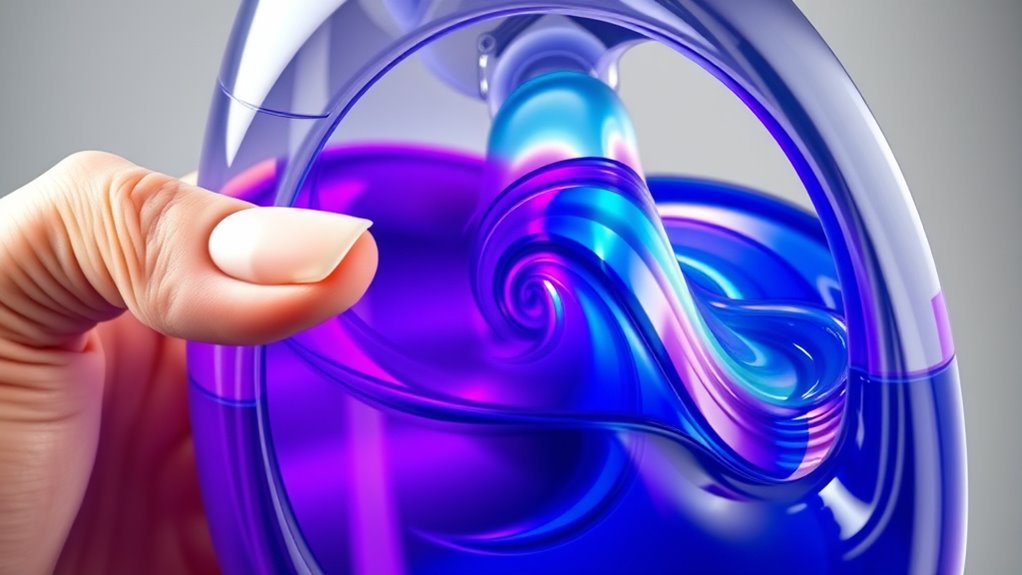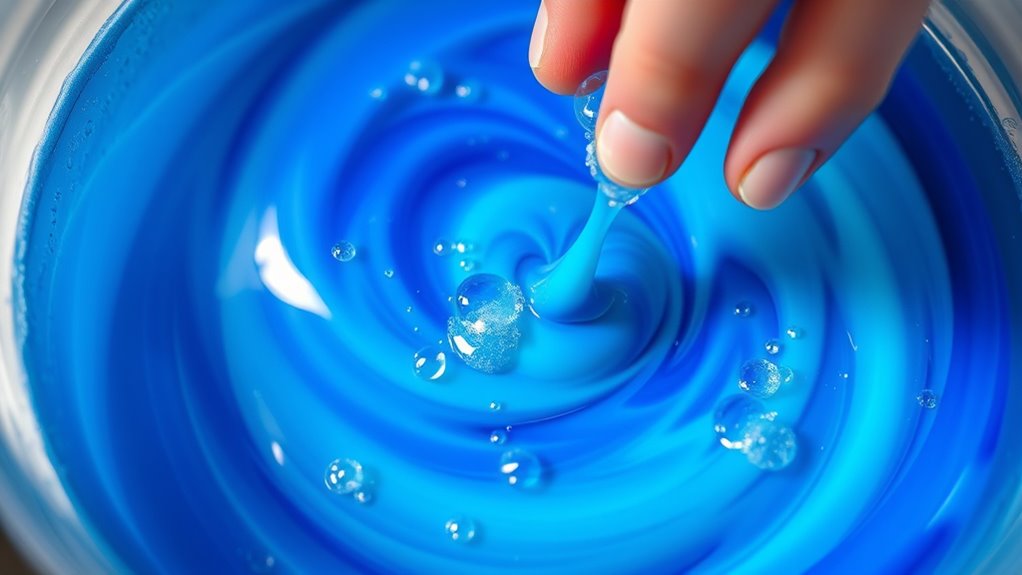Color-changing laundry detergents work by using special pH indicators that respond to changes in water acidity or alkalinity during the wash cycle. As the detergent interacts with dirt and stains, it causes the water’s pH to shift, which triggers the indicators to change color. This visual cue helps you monitor cleaning progress and know when the process is complete. If you’re curious about the details, there’s more to uncover about how chemistry enhances your laundry experience.
Key Takeaways
- Color-changing laundry detergents contain pH indicators that respond to changes in the chemical environment during washing.
- These indicators alter their molecular structure when exposed to different pH levels, causing visible color shifts.
- As the detergent interacts with dirt and stains, it can change the water’s pH, triggering a color change in the indicator.
- The color change provides a visual cue indicating active cleaning or stain removal progress.
- This combination of chemical reactions and visual signals helps users monitor the effectiveness of the wash cycle.

Have you ever noticed your laundry detergent changing color during the wash? It might seem like magic, but it’s actually thanks to clever chemistry. These detergents contain special ingredients that undergo chemical reactions in response to different conditions inside the wash cycle. At the heart of this process are pH indicators—compounds that change color depending on the acidity or alkalinity of their environment.
When you add detergent to water, it interacts with dirt, grease, and stains, creating a dynamic chemical environment. The pH of this environment can shift as the detergent works, which triggers the pH indicators to change color. Additionally, these indicators are carefully selected to respond predictably to specific pH levels, ensuring accurate visual cues during the wash.
These pH indicators are carefully selected chemicals that respond predictably to changes in acidity or alkalinity. For example, some indicators turn from red to yellow as the solution becomes more alkaline, while others shift from blue to pink under acidic conditions.
In color-changing laundry detergents, these indicators are embedded into the formula so that they can visually signal the progress of the cleaning process. When you start the wash, the water’s pH might be neutral or slightly alkaline, and the indicator displays a specific color.
As the detergent dissolves and interacts with stains, it often increases the water’s alkalinity, causing the indicator to change color. This visual cue can help you see that the detergent is actively working. The chemical reactions involved are influenced by the ions released from both the stains and the detergent itself.
The changing colors are the result of chemical reactions between the pH indicators and the ions present in the water. The indicators have molecular structures that respond to proton concentration—essentially, how many hydrogen ions are present.
When the pH shifts due to cleaning agents breaking down stains or released from the detergent itself, the molecular structure of the indicator rearranges. This rearrangement causes a change in how the molecule absorbs and reflects light, producing a visible color change.
Because these indicators are precise and responsive, they make it easy for you to observe the cleaning process visually. In essence, the color change isn’t just for show; it’s a sophisticated way to monitor the chemistry happening inside your washing machine.
Understanding the chemical reactions involved, including the role of pH indicators, helps explain how these detergents provide both cleaning power and visual feedback. They help you ensure your laundry is thoroughly cleaned and give you a better sense of when the wash cycle is complete.
Frequently Asked Questions
Do Color-Changing Detergents Work on All Fabric Types?
You wonder if color-changing detergents work on all fabric types. They generally perform well on most, but fabric compatibility and dye stability vary. Some delicate or synthetic fabrics mightn’t respond as effectively, and dyes could fade or run.
To guarantee the best results, check the detergent’s label for fabric recommendations and test on a small area first. This helps protect your clothes and maintains vibrant colors over time.
Are Color-Changing Detergents Safe for Sensitive Skin?
You might wonder if color-changing laundry detergents are safe for sensitive skin. They often contain hypoallergenic ingredients, making them gentler for those with skin sensitivity. However, it’s crucial to check the label for specific hypoallergenic claims and avoid harsh chemicals.
If you have allergies or very sensitive skin, consider doing a patch test first. Generally, detergents with hypoallergenic formulas are a safer choice for avoiding skin irritation.
How Long Do the Color Changes Last During Washing?
Imagine a chameleon blending seamlessly; that’s how long your laundry’s color change lasts—usually during the wash cycle itself. This temporary shift helps with stain prevention and enhances color retention, but it’s fleeting.
Once the cycle ends, the colors revert, ensuring your clothes look vibrant again. The effect’s brief nature means it’s perfect for identifying stains early, but it doesn’t linger long enough to affect your laundry’s overall appearance.
Can These Detergents Stain or Discolor Clothes?
You might wonder if color-changing detergents stain or discolor clothes. Generally, they’re designed to be fabric compatible and won’t cause stains or discoloration when used properly.
To prevent any issues, always check the detergent label for fabric compatibility and follow the instructions carefully. Proper use guarantees stain prevention and keeps your clothes looking fresh without accidental color changes or damage.
Are Color-Changing Detergents Environmentally Friendly?
You might wonder if color-changing laundry detergents are eco-friendly. These detergents often have a lower environmental impact because they use eco-friendly ingredients that reduce pollution and water contamination.
However, some formulations may contain synthetic chemicals that harm the environment. To minimize your impact, look for products labeled as biodegradable or made with sustainable ingredients, ensuring you’re choosing a detergent that’s better for the planet while keeping your clothes clean.
Conclusion
So, next time you notice your detergent change color, remember it’s not just a coincidence—it’s a clever trick designed to keep your clothes fresh. Just like how a sudden shift in the sky hints at rain, these color changes hint that your laundry is being cleaned effectively. It’s almost like your detergent has a secret message, whispering, “I’ve got this under control.” Who knew laundry could be so fascinating?









